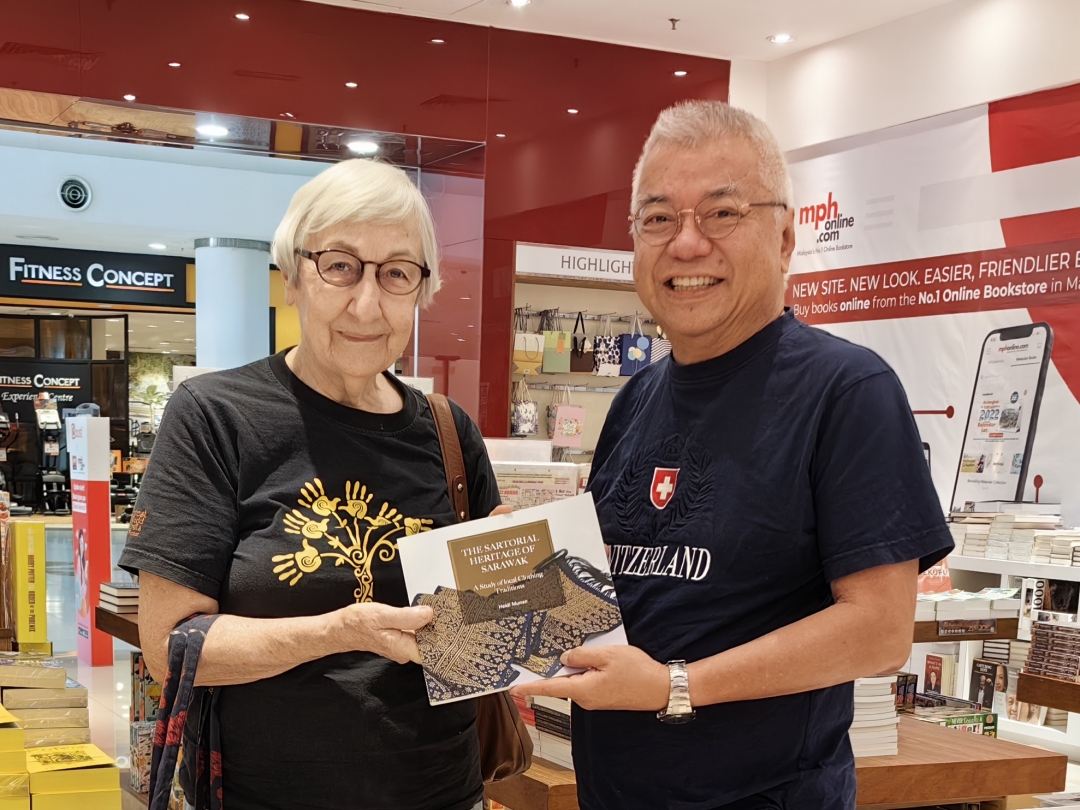
The columnist with Heidi Munan, seen holding her latest book ‘The Sartorial Heritage of Sarawak’.

LAST Saturday (Jan 7), prolific writer Heidi Munan had launched her latest in a long and impressive line of books ‘The Sartorial Heritage of Sarawak (A Study of Local Clothing Traditions)’, at the Telang Usan Hotel in Kuching, amidst a fanfare of local Iban warriors clad in their colourful and striking traditional attire (I was uncertain if they were ceremonial, or in preparation for battle!).
The 128-page book, printed on art paper and lavishly illustrated with photographs and drawings, was published and commissioned by Pustaka Negeri Sarawak.
You can buy copies, at RM60 each, at The Milk Shop, Jalan Tabuan Dayak; by contacting Philippa Munan on +6011-1605 3616; or emailing her via [email protected].
According to the Oxford Dictionary, the word ‘sartorial’ means ‘relating to clothes and to the way they are made or worn’.

The book cover of Heidi’s latest publication.
Born in Weinfelden, Switzerland, Adelheid Munan (she took on the easier-to-remember name ‘Heidi’ later in life) had studied at Auckland University in New Zealand where she had met a young Colombo Plan scholarship Iban student from Sarawak named Sidi Munan – they both settled down in Kuching in 1965.
Heidi has written at least 15 other books, some of which became national best-sellers; these included ‘Culture Shock Borneo & Culture Shock Malaysia’ for TIMES Editions; ‘Sarawak Crafts’, ‘Iban Stories’, ‘Sarawak Stories’, ‘Sarawak Historical Landmarks’, ‘Sarawak Folk Tales’, and more.
She has been studying the material culture and history of Sarawak for over 50 years, and in her capacity as a private researcher, she has had ample opportunity to study and learn from indigenous experts and foreign scholars in many related fields.
She has been the honorary curator of the Sarawak Museum for a great many years, and has written the authoritative volume entitled ‘Beads of Borneo’ for Editions Didier Millet in 2005, which is still in print.
Two of her other books are also held in high regard: ‘Food Heritage of Sarawak – A Cultural Perspective’ for the Department of Heritage in Malaysia; and ‘Music without Borders – Rainforest World Music Festival’ for Marshall Cavendish in 2007 (now out of print).
I was interviewed for that last title in 2006.
I asked Heidi what had inspired her to write this latest book. She responded by saying that her interest in the beads of Borneo had taken her to many remote places and in the course of her study, she became very interested in the history of the attire, the way, whys and whereofs of how the Borneo people had dressed themselves through the ages.
It had taken her right back to the Niah Caves in Sarawak where Borneo’s earliest man was found – the 40,000-year-old ‘Niah Man’.
On Page 13 of her new book, Heidi described the earliest fabric fragment that was found in the Niah Caves: “A badly deteriorated shred of fabric…it looks very dark brown or black…it still shows the thread, much finer than the local homespun materials …it was finally used to wrap or dress a deceased member on his way to the underworld because it was so precious.”
Including the usual foreword and bibliography, there are 14 parts (chapters) in Heidi’s new book. It starts with ‘Long Long Ago in that Niah Caves of Sarawak 40,000 years’, passes through ‘From Fabric to Clothing’; ‘Window on the Past’; ‘Better Tools, New Skills’; ‘The 20th Century’; ‘New Dawn’, and ends with ‘Into the Millennium’.
The photos and illustrations shared with the readers are useful, interesting and many are most revealing indeed.
I was captivated with Chapter 5, which had dwelled on ‘The 20th Century’ as I had borne personal witness to this era from the 1950s right into the 2000s – of how fashion had evolved from the time of my grandparents to that of my children now; in my family a stretch of four generations.
Gosh! Has the world of fashion really changed that drastically in such a short period of time?

A page on the fashion trends in 2022.
I would like to quote Heidi herself writing in her introduction, about the part of her history that had involved my family, the Peranakans.
It goes: “Another Chinese demographic, less numerous but socially and politically very influential, were the offspring of migrants into the Southeast Asian archipelago who had come to live permanently in the major towns of Malaya, Thailand and the Dutch East Indies.
“They were known as the ‘Peranakan’ (locally born) or Nyonya community…All these new settlers contributed to the cultural mix that makes up today’s Sarawak, all were inevitably touched by influences from far-away lands which grew stronger after the mid-20th century.”
I would recommend and urge all those interested in the social, cultural and human history of Sarawak to buy Heidi’s latest book – it’s a marvel and a keeper!

This section depicts the history of the cheongsam, with the photos captioned: ‘Two versions of the cheongsam: demure, or daring’.
Heidi Munan has since received the Sarawak Hornbill Tourism Award as well as the Malaysian Tourism Award for her journalism in recent years. She has been actively involved in tourism and handicrafts promotion, and has been responsible for the publication of many feature articles, papers and essays on various topics related to Sarawak in particular, and Borneo in general.
Heidi and Sidi Munan have two children and nine grandchildren.
I have known Heidi personally since the 1970s – my parents as well as family members were friends with both Sidi and Heidi. During his earlier years, Sidi was very active in Sarawak politics and in that field, the Ongs and the Munans had socialised and became friends.
Heidi, in her many associations with and involvement in the arts, crafts and cultural side of local affairs, had become close to our Ong family through my brother Edric (who had led the Atelier Society Sarawak for many years), cousin Ramsay (the famous batik artist) and others of the ilk like Michael Lim.
Heidi is extremely well-versed insofar as local native history, culture, arts and crafts, as well as legendary stories are concerned. Throughout the years that I’ve known her, she has been very generous with her sharing of this knowledge and I had, on many occasions, sat together with her at meetings and events.
Indeed, we were part of the early days during the pre-conception and creation of the Rainforest World Music Festival in 1997, which was initiated by the Society Atelier Sarawak; the WEFT Forum and the exhibition and shows; the International Delphic Games (which was later regurgitated into another event); as well as the World Communication and Environment Conference (with David Suzuki).
Regina Fabiny of Leisure Guides Malaysia had also involved us, together with Edric and Dyan Ong and others like Datin Dona Drury Wee and Felicity Lee in the publication of the Sarawak State Government’s ‘The Guide to Sarawak’ in 2014 – it was published in 2016, and a revised updated edition is now overdue.
As mentioned earlier, our families go back a long way. Heidi’s husband, the indomitable Sidi Munan, is my fellow columnist in The Borneo Post (he has been writing for this newspaper much longer than myself), and their son Brangka Munan sits on my current board of management at our alma mater, St Thomas’s Secondary School.
Heidi has personally been my ‘go-to consultant’ on various aspects during the making of two of Hollywood’s biggest feature films produced on location in Sarawak – the first was ‘Farewell to the King’ in 1987, and then ‘The Sleeping Dictionary’ in 2000.
In return, I was able to tip her off come every Christmas time as to where to locate in Kuching her favourite bottle of port or sherry! After all, in the film industry my official capacity/job description is that of a ‘fixer’!
I was somewhat tickled and amused by Heidi’s acknowledgement at the end of her book with regards to those who had ‘given a bit of themselves’, among whom were a few of my family members: my brother Edric Ong whom she had called a ‘veteran art promoter’; artists cousin Ramsay Ong and Michael Lim; cousin-in-law Rose Bennet; nephew Donald Tan; and finally myself – ‘Edgar Ong was my ‘all-round’ informant with his excellent memory for events and dates, and of course films!’
I’m sure she’s now hard at work on her next book or project – our prolific and esteemed writer, researcher, historian and custodian of Sarawak’s written heritage.
Heidi has always been well-researched, thorough and is hugely competent in her writing.
Congratulations my friend – Sarawak is that much richer due to your past efforts!
